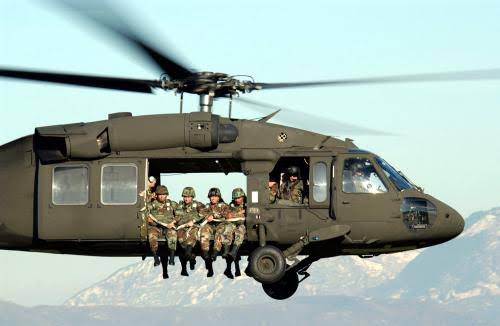UH 60 Helicopter Review: Everything You Need to Know
UH 60 Helicopter Review: Everything You Need to Know
Blog Article
The Effect of Lasting Practices on the Future of Aircraft Workflow and Emissions Reduction
As the aviation sector faces increasing analysis over its environmental impact, the fostering of lasting practices becomes a crucial path towards future aircraft procedures and discharges decrease. Developments in sustainable air travel fuels and developments in hybrid propulsion innovations stand at the center of this transformation, encouraging considerable decreases in greenhouse gas exhausts. Nevertheless, the successful assimilation of these initiatives depends upon a range of factors, consisting of regulative frameworks and industry collaboration. The question stays: just how will these developing methods reshape the characteristics of flight and add to a much more sustainable future?

Overview of Sustainable Practices
Lasting techniques in airplane procedures encompass a series of strategies aimed at minimizing ecological influence while maintaining operational efficiency. These practices are vital in the aeronautics sector's dedication to decreasing its carbon footprint and sticking to worldwide ecological requirements. Key campaigns include maximizing trip courses to decrease gas usage, improving maintenance protocols to make certain airplane run at peak effectiveness, and implementing innovative technologies such as winglets and light-weight materials that improve aerodynamics.

Involving and educating personnel on sustainability techniques additionally play an essential function, cultivating a culture of ecological duty within organizations. On the whole, the integration of these sustainable techniques not just helps in reducing discharges yet likewise boosts the long-term viability of the air travel market, guaranteeing it meets the demands of both consumers and regulative bodies while adding to worldwide sustainability objectives.
Innovative Gas Alternatives
Many ingenious fuel choices are becoming pivotal remedies to decrease the aeronautics industry's reliance on standard nonrenewable fuel sources. Among these alternatives, Lasting Aviation Gas (SAFs) have gained substantial interest as a result of their prospective to decrease lifecycle greenhouse gas discharges by as much as 80% compared to conventional jet gas. SAFs are originated from various feedstocks, consisting of waste oils, agricultural residues, and also algae, making them a functional alternative for the market.
Another appealing alternative is hydrogen gas, which, when utilized in fuel cells, generates just water vapor as a by-product. Furthermore, electric propulsion systems are being discovered, leveraging battery innovation to power airplane.
Lastly, biofuels stemmed from biomass are being explored, offering a sustainable choice that can be blended with traditional gas. Collectively, these cutting-edge gas alternatives stand for an essential action towards attaining a lasting air travel ecological community, lining up with worldwide exhausts reduction targets and boosting the market's environmental stewardship.
Technological Advancements in Aeronautics

Just how can technical improvements reshape the future of air travel? Innovations such as electrical and hybrid propulsion systems are at the center, encouraging substantial decreases in fuel consumption and greenhouse gas emissions.
Additionally, the execution of innovative products, such as lightweight composites, contributes to boosted aerodynamics and gas performance. Making use of expert system and device understanding in trip procedures useful site optimizes course planning and minimizes gas burn by making it possible for real-time modifications based on weather condition and website traffic conditions. Furthermore, the development of independent and remotely piloted airplane systems stands to change cargo and guest transportation, potentially boosting effectiveness while minimizing human mistake.
Moreover, sustainable aeronautics modern technologies, consisting of advanced air website traffic monitoring systems, can improve procedures and minimize blockage, leading to lower exhausts during trip. These developments jointly represent a paradigm change in aeronautics, promising a future where sustainability and operational effectiveness are linked, thereby supporting the sector's commitment to minimizing its environmental impact.

Governing Structure and Compliance
Because of the expanding emphasis on ecological stewardship within the aeronautics sector, the governing framework regulating airplane procedures is progressing to promote lasting techniques. Regulative bodies, such as the International Civil Aviation Company (ICAO) and numerous national aeronautics authorities, are introducing rigid standards aimed at decreasing emissions and enhancing functional performance.
These guidelines commonly consist of the adoption of Lasting Aeronautics Gas (SAF), which has actually been identified as a vital component in attaining lower carbon impacts. Furthermore, conformity with these policies requires airline companies to implement advanced modern technologies and functional practices, such as maximized flight paths and enhanced air website traffic administration, to minimize gas usage.
In addition, the enforcement of emissions trading schemes and carbon countering efforts is coming to be increasingly widespread, engaging airlines to keep an eye on and report their emissions properly. Non-compliance can result in considerable charges, hence pushing operators to focus on sustainability in their company designs.
Ultimately, the progressing regulative landscape not just drives technology and financial investment in environment-friendly modern technologies but likewise cultivates a culture of accountability within the aviation sector. As these frameworks remain to create, the emphasis on lasting practices will certainly be indispensable to attaining the sector's long-lasting ecological objectives.
Future Patterns in Aircraft Workflow
As the air travel industry adapts to a progressively rigid governing setting, future patterns in airplane operations are readied to concentrate on innovative solutions that better boost sustainability and efficiency - uh 60. Trick growths will likely include the adoption of advanced air traffic administration systems, which use real-time information and expert system to enhance trip courses, reducing gas consumption and discharges
An additional significant pattern is the enhanced assimilation of sustainable aviation gas (SAFs) These alternatives to conventional jet fuel, stemmed from sustainable sources, can considerably decrease lifecycle moved here greenhouse gas discharges. The sector's commitment to SAFs will likely increase as airline companies collaborate with gas producers to make sure availability and cost-effectiveness.
Furthermore, the press in the direction of electrification and crossbreed propulsion systems is obtaining energy. Arising aircraft layouts will incorporate these innovations, using quieter and extra reliable operations, specifically for short-haul trips.
Conclusion
Finally, the combination of sustainable methods in airplane procedures holds significant possibility for emissions reduction and enhanced efficiency. The adoption of lasting aeronautics gas, coupled with innovations in electric and hybrid propulsion web link systems, is vital for minimizing lifecycle greenhouse gas emissions. Maximizing flight courses and accepting innovative innovations add to a quieter and more environmentally friendly air travel field. Collectively, these efforts line up with worldwide sustainability goals and lead the way for a greener future in aeronautics.
Technologies in sustainable air travel gas and developments in hybrid propulsion innovations stand at the forefront of this transformation, promising considerable decreases in greenhouse gas exhausts.Various ingenious fuel choices are arising as pivotal services to decrease the aeronautics industry's dependence on conventional fossil fuels - uh 60. Amongst these alternatives, Lasting Aeronautics Gas (SAFs) have actually gained considerable focus due to their possible to reduce lifecycle greenhouse gas discharges by up to 80% contrasted to conventional jet fuels.One more considerable pattern is the raised combination of sustainable air travel gas (SAFs) The adoption of lasting aviation gas, combined with developments in hybrid and electric propulsion systems, is vital for minimizing lifecycle greenhouse gas exhausts
Report this page